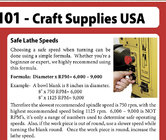I've been turning on a Powermatic 2014 that has three belt positions. That allows for 15-900 rpm with high torque, 30-1800 rpm, and 60-3600 rpm.
I am a relative newbie and have been turing around a 12 months in the last 18 months.
Up until recently have not changed the belt from the lowest setting.
Now I am chasing after an extremely smooth finishing cut. What speeds and tools do you all recommend for finishing cuts?
I am using a reground 1 1/4" round nose scraper with a 25° negative rake angle. I have been sharpening both faces (80° and then 25°) and using a 600/1000 grit diamond stone to remove the burr left from the wheel. I then use a carbide rod to raise a burr on the 25° face. Now I am using it at between 1800 - 2500 r.p.m.s. I have noticed that the burr does not last very long. I've also noticed the scraper will catch on the tool rest so now I've rounded the bottom edges of the negative rake scraper and I have started filing my tool rest smooth and then applying that green lubricant stick for sharpening tools onto it. That helps.
In addition to the negative rake scraper I have been using a two faced skew with both faces ground to 35° (70 ° total). This works as well... maybe better.
Lastly I will use my5/8ths" bowl gouge with a 55° bevel and long swept back wings. Good results.
What speed do you use with these tools for finish cuts?
Any other tool that seems to cut better at 2500 r.p.m.s?
I have not joined a local club and may not until things settle down a bit. I do watch many Y.T. demos so even a few of those would be appreciated if they are especially good.
What tools do you use for 2500 + r.p.m.s or tools to absolutely avoid at faster r.p.m.s.
Thanks in advance.
Al in Texas~
I am a relative newbie and have been turing around a 12 months in the last 18 months.
Up until recently have not changed the belt from the lowest setting.
Now I am chasing after an extremely smooth finishing cut. What speeds and tools do you all recommend for finishing cuts?
I am using a reground 1 1/4" round nose scraper with a 25° negative rake angle. I have been sharpening both faces (80° and then 25°) and using a 600/1000 grit diamond stone to remove the burr left from the wheel. I then use a carbide rod to raise a burr on the 25° face. Now I am using it at between 1800 - 2500 r.p.m.s. I have noticed that the burr does not last very long. I've also noticed the scraper will catch on the tool rest so now I've rounded the bottom edges of the negative rake scraper and I have started filing my tool rest smooth and then applying that green lubricant stick for sharpening tools onto it. That helps.
In addition to the negative rake scraper I have been using a two faced skew with both faces ground to 35° (70 ° total). This works as well... maybe better.
Lastly I will use my5/8ths" bowl gouge with a 55° bevel and long swept back wings. Good results.
What speed do you use with these tools for finish cuts?
Any other tool that seems to cut better at 2500 r.p.m.s?
I have not joined a local club and may not until things settle down a bit. I do watch many Y.T. demos so even a few of those would be appreciated if they are especially good.
What tools do you use for 2500 + r.p.m.s or tools to absolutely avoid at faster r.p.m.s.
Thanks in advance.
Al in Texas~

